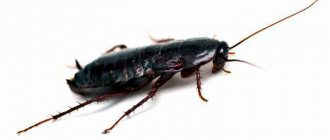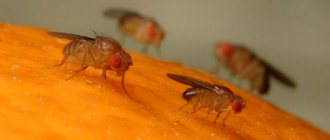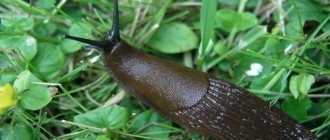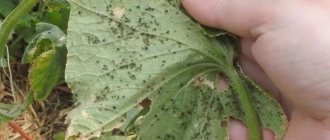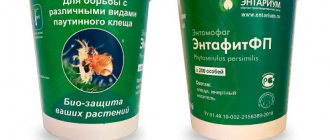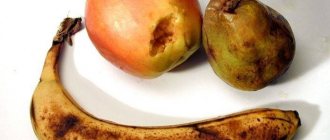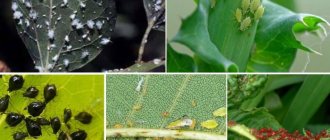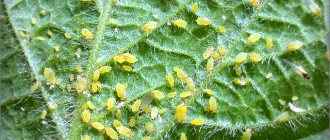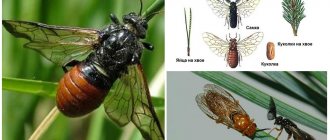We choose proven means to get rid of flies in a flower pot
Even an attentive and experienced gardener can get flies on indoor plants in flower pots. How to get rid of uninvited insects without waiting for them to spread to all plants, and what measures to take to prevent re-infection - these issues should be resolved quickly and competently. And then the home flower garden will again delight with strong, healthy shoots.
What kind of flies can appear in flower pots?
A huge number of different pests can get into flower pots with garden soil. But most often, three types of insects breed in them and begin to reproduce:
- Drosophila - fruit flies or fruit flies, similar in appearance to small flies;
- sciarids - the so-called fungus gnats;
- whiteflies - they look like very small butterflies with two white wings.
Drosophila are ubiquitous in nature, feeding on plant sap and decaying plant debris. Fruit flies have a short life cycle and extraordinary fertility.
Sciarids are relatively little studied and include up to 20,000 species. The most famous are mushroom, cucumber, potato, and greenhouse. In this biological species, adults do not feed, and the larvae eat fungal mycelium, roots of higher plants, and decaying plant tissue.
Whiteflies, or aleurodids, live on the undersides of leaves and feed on plant sap. Some of their species are dangerous quarantine pests.
How midges get into flower pots
These midges can appear in a pot in different ways:
- end up in purchased or garden soil that is poorly disinfected;
- fly through an open window in the summer and lay eggs in the damp soil of a flower pot;
- get together with vegetables or fruits and multiply, and then migrate to flowers.
Excessive soil moisture promotes the fastest reproduction of midges in flower pots. In warm and humid conditions, larvae quickly hatch from laid eggs and begin to actively feed. Soon this becomes noticeable by the unhealthy appearance of the indoor plant - it withers, the leaves wither and fall off, despite abundant watering.
In the initial stage, plant infection is difficult to determine. You should carefully examine it - the top layer of soil and the underside of the leaves.
If insects are noticed on the leaves, and small white larvae are found in the ground, urgent measures need to be taken before the pests spread everywhere.
Why do flower midges appear?
Even the most careful and regular care cannot guarantee that the flowers in the house will not be attacked by pests. The occurrence of pests of flower plants in an apartment can be due to a number of the following easily explainable reasons:
- The soil remains too moist after watering. If moisture begins to stagnate in a flower pot, this becomes a favorable breeding ground for midge larvae in the ground.
- The larvae can get into the pot along with soil purchased at the market or in a store. This can be explained by the fact that the substrate was of poor quality or was not disinfected.
- Black sciarid midges often fly into the apartment from the street. Pots with flowers placed on the windowsill for ventilation, the soil in which is full of moisture, will be an excellent place for midges to lay eggs. For white midges, the place of entry into the room can be the ventilation openings of damp basements and cellars.
- Many gardeners themselves create a fertile environment for the reproduction of flower midges. If you water flowers with settled tea leaves or coffee solution, as well as other organic matter, which is strongly recommended to be used at home by “people’s advice,” you may run the risk of soon appearing in pots of both sciarids and stalks.
Folk recipes for fighting fly
At first, you can try to get rid of midges in pots using traditional methods and start with the least traumatic ones for the plant.
First you need to let the soil dry at least two centimeters and slightly loosen its top layer. In such conditions, it is difficult for the larvae to survive, as they need a moist environment. Then catch all the flying insects. This is done using glue traps.
The simplest ones are a kind of flag made from a rectangle of thick paper on a toothpick. The paper is coated with chalk or molasses and stuck into the ground among the leaves. Traps are replaced as necessary. During this time, the plant should be watered very sparingly so that the top layer of soil does not get wet. The best way to do this is to place the pot in a large container of water. The window sill and the surface of the ground are treated with a vacuum cleaner without a brush. It easily attracts any flying insects.
After processing, the disposable bag should be thrown away, the regular bag should be emptied outside the apartment and disinfected with dichlorvos.
After destroying adult midges in indoor pots, you need to deal with the soil, in which a large number of larvae still remain. The dried and loosened soil is watered with a solution of one of the proven folk recipes:
- Garlic infusion. Chop one head of garlic and add 0.5 liters of water. The infusion is kept for several hours, then the ground is watered abundantly, the entire plant is sprayed, and the remaining garlic pulp is mixed with the top layer of soil.
- Potassium permanganate solution. Treat the plant with a weak pale pink solution once a week.
- Soap solution. Dissolve 20 g of laundry soap in one liter of warm water. The resulting soapy water is watered and sprayed on the diseased specimen weekly.
- Anti-worm medication for pets. It is diluted in a dosage suitable for treating cats and puppies and watered on the affected plant every week.
Folk remedies help with low levels of infection.
It is also convenient to remove midges from flowers in pots using a plastic bag large enough to fit the entire plant. It is important to position the bag so that not a single branch is crushed. Dichlorvos is sprayed under the bag and quickly tied with a rope in the middle of the pot. In such a greenhouse, all insects die within a few hours. It is necessary to remove the bag in another room where the flowers were not standing, and in the same place, treat with a vacuum cleaner and place glue traps. After two weeks, the plants treated with dichlorvos are returned to their place.
How to get rid of it: methods of struggle
The fight against parasites will require a systematic, persistent and comprehensive approach from the grower. If midges appear on just one plant, there is a high probability that they will soon settle on all the pots. Individuals lay eggs, from which voracious larvae hatch in a short time. When fighting midges, an integrated approach is required:
- First of all, you need to wait until the top layer of soil dries at least 2 cm.
- Sticky tapes or a vacuum cleaner are suitable for catching insects.
- The most effective way is to transplant the infected plant into a new pot.
You can make your own sticky tape using strips of yellow paper and honey.
If the scale of the damage is not very serious, improvised means will be sufficient:
- We dilute 50 g of ammonia in four liters of water and get not only an insect repellent, but also an excellent nitrogen fertilizer. Spraying can be done once a week.
- Potassium permanganate can leave pests without food. To achieve results, water the plant at least 2 times.
- We dilute a teaspoon of apple cider vinegar in a liter of water and spray it on indoor flowers.
- Repels midges and the strong smell of tobacco. We carefully loosen the soil in the pot, and spread tobacco on its surface.
- The top layers of soil can also be sprinkled with ground cinnamon: midges cannot stand its smell.
- We stick matches with their heads down into slightly moistened soil. We change them as necessary.
- Dissolve a spoonful of chili pepper in three glasses of boiling water. Cover the container with a towel and leave for several hours, then strain.
- Place freshly cut orange peel in the ground.
- Grind a clove of garlic and add a liter of settled water. The mixture will infuse for 24 hours in a dark place. Afterwards the plant can be sprayed. This method is especially popular among German flower growers.
Whiteflies are removed with a soft cloth soaked in soapy water. It is best to use cheap laundry soap without additives.
You can simply place the plant under a cold shower:
Indoors, it is advisable to try to cope with folk recipes, but this is not always possible. Then industrial means will come to the rescue. Any chemicals are toxic: when working with them, be sure to wear gloves and safety glasses, and when finished, ventilate the room.
In a specialized store, consultants will tell you which product is best.
- Iskra Bio helps to cope not only with midges, but also with other indoor pests: thrips, spider mites.
- “Golden Spark” is made in the form of convenient sticks and serves not only as a means of protection, but also as an excellent supplement. The drug fights against aphids, scale insects and midges. Pests die a few days after treatment.
- Aerosol insecticides "Bona Forte" are capable of destroying flying pests in one moment.
- There are preparations in the form of granules: “Grom-2”, “Mukhoed”. As they dissolve, they will have a detrimental effect on pests. Usually just one procedure is enough.
- Chalk "Mashenka" destroys not only cockroaches, but also the larvae of flying insects. To do this, it is crushed and the powder is sprinkled on the soil.
After treatment, it is not recommended to water the plant for three days. Each drug has a number of features, ranging from temperature conditions to permissible concentrations.
Chemical repellents
If folk remedies have not helped get rid of flies in a flower pot, you cannot do without the achievements of modern chemistry. Heavily contaminated soil must be replaced completely, freeing the roots from it. Then the entire plant along with the roots is treated with one of the special insecticides. “Fitoverm”, “Aktellik”, “Bazudin”, “Aktara” are suitable for exterminating pests.
To prevent re-infestation, you should only use soil that has been steamed or spilled with insecticide and follow the watering regime, avoiding excessive moisture in the soil in the pot.
Ways to combat flower flies - video
Why do these pests appear on flowerpots?
Midges may appear in flowers and on the surface of the soil of flowerpots in the following cases:
How to get rid of midges in flowers
- poor quality soil for planting flowers. It may contain particles of plants that have not completely rotted, which will later become a breeding ground for insects;
- use for watering tea or other liquids other than water;
- replanting flowerpots into too large a pot. In this case, in the lower part the soil is too moist, since the roots of the plant cannot absorb water at this level;
- intensive watering of the soil. Stagnation of water in the soil provokes putrefactive processes that attract insects;
- use of organic endorsements.
Varieties of midges
The following types of insects can live on flowerpots:
- white midges - springtails. These insects most often appear on the surface of the soil or near the bottom of the stems of plants that have been watered too much. Most often they are discovered in winter or in the first half of spring, when moisture from flowerpots does not evaporate so intensely;
- black midges - sciarids. They are not dangerous to humans, but can cause poor growth or death of the flower. Larvae are laid in the ground, which negatively affect the root system of the flowerpot.
Enhytrea
These insects, which look like small white worms (about 1 cm long), can be seen if you remove the plant from the pot. Enchytraeas are an excellent food for aquarium fish; for plants, they are considered, in general, harmless, since they feed primarily on dead plant tissue. Enchytraea is a signal that a swamp has been created in the pot, the plant is over-watered, and the roots rot from excessive watering - and the enchytraea eats them up. As a result, the plant is suppressed and stunted in growth, dying rather from overwatering than from white worms.
Control measures. If these pests are detected, you need to wash the roots from the old soil and plant the plant in fresh soil. If the plant cannot be replanted for some reason, then you need to water the soil with an insecticide solution. And carefully loosen the soil. If such white worms appear in flower pots, think that perhaps you are watering the flowers too much! Enchytraea is usually introduced with organic fertilizers or garden soil. But if watering is not too frequent, the worms dry out and die.
How to get rid of midges in flowers
In this material we will tell you how to get rid of midges in indoor flowers using folk and special means, namely the following 3 types:
- Drosophila, also called fruit flies or fruit flies. They look more like small flies.
- Sciarids, other names are flower gnats or fungus gnats, and they really do look a lot like small black gnats.
- Whiteflies or Aleroidids, which look like small white or light gray small aphids. They settle mainly under leaves.
We will look at ways to combat fruit and flower flies in the first chapter, but if white flies have settled in your plants, then you can find out how to get rid of them in the second part of the material.
Types of flower pests
When midges appear in indoor flowers, it is important to find out what type of pests threaten the health of your green pet. This knowledge will help you find the right method with which you can quickly and effectively deal with annoying insects.
The most famous insects to gardeners that settle in flower pots are 2 types:
- Sciarides. Small black or grayish midges, also called fungus gnats. They belong to the order Diptera. Their dimensions do not exceed two millimeters. They are easy to spot as they migrate from flower to flower, causing a lot of trouble in the house. The female insect lays eggs in moist soil; midges are especially attracted to those soils in which decomposition of organic matter occurs. The most susceptible plants to invasion by sciarids are violet, azalea, and various types of ficus.
- Springtails. A species of white wingless midges, also called springtails. They move around flowers by crawling, and adult insects make active jumps. Particularly dangerous are the larvae that eat the roots of plants. The period of active reproduction of springtails is winter and spring. These small white midges are partial to the delicate leaves of fuchsia and begonia. They also cause a lot of trouble for lovers of indoor orchids.
Flower midges are unlikely to harm human health, because they do not carry infections and do not sting. An exception may be overly impressionable people and small children, who may be frightened by the threatening activity of a horde of small insects.
Adult midges can cause irreparable damage to plants. By migrating between flowers, they can increase the risk of plant infection with a harmful fungus, as well as be carriers of the larvae of other harmful insects.
How to get rid of fruit and flower midges (drosophila and sciarid flies)
Midges in flowers are not only small flying flies, but also their larvae that live in the ground. Several generations of insects can simultaneously develop in one pot, from eggs to adults. Also, keep in mind that fungus gnats can spread quite quickly from one plant to another. Therefore, in order to remove insects forever, you need to fight them comprehensively and often repeatedly.
Why midges appear in indoor flowers: a common reason is that they could appear when the plant was transplanted into purchased soil, which was already infested with eggs and larvae. In addition, midges could simply fly in from a window in summer or autumn and settle in your flowers. One way or another, the main factor in the emergence and reproduction of sciarids and fruit flies is moist, overwatered soil, which attracts midges and creates favorable conditions for the transformation of dormant eggs into larvae. By the way, fruit flies could get into your apartment along with purchased vegetables, fruits, or fly to the smell of a stale product, and only then take a fancy to your flower pots.
Damage caused: adult individuals are harmless in themselves, but their larvae, feeding on the sap of the roots, destroy the plant. Flower midges are especially dangerous for seedlings and young plants.
Prevention: watering plants as the top 2 cm of soil dries, as well as periodic loosening and timely removal of diseased leaves. Moderate watering will make the soil less attractive to egg-laying adult midges and less favorable for the development of larvae.
Fighting methods
Instructions 1. Using folk remedies
Step 1. Let the soil dry out after the last watering so that at least 2 cm of the top layer is dry.
Step 2: Catch all adults. You can do this using:
- Traps: special (for example, a regular fly catching tape will do) or homemade ones. To make your own midge traps, you will need yellow cardboard (or cardboard painted yellow) and honey. Yellow cards should be coated with a thin layer of honey and hung (placed) near the pots. Remember to change traps as needed.
- Vacuum cleaner: remove the attachment or attach a small attachment without a brush to the hose and simply work the ground and window sill with it. The vacuum cleaner will easily capture insects even in flight. After this, the bag must be thrown away (if it is disposable) or emptied outside the apartment, and then treated with dichlorvos.
How to get rid of whiteflies
To get rid of whiteflies, you also need to carry out comprehensive measures to destroy adult insects and larvae 3-4 times with an interval of one week.
Damage caused: whiteflies themselves do not harm the plant, but due to their excrement, sooty fungi may appear on the lower leaves, which can seriously damage the flower. In addition, white midges can infect the plant with a viral infection. On the right is a photo of a leaf affected by whitewing.
Fighting methods
Step 1. First you need to catch all the adult flies. You can do this in the following ways:
- Place special or homemade traps described in the first instructions.
- Catch all the midges with a vacuum cleaner.
- Pour jam into a saucer, place it next to the pot and wait until the whiteflies fly to the bait and get stuck in it.
- In the morning, create a slight coolness in the room where the flowers are located, for example, by turning off the radiators or opening a window. The lower temperature will prevent the flies from taking off. Next, follow the procedure described below.
Step 2: Once most of the adult whiteflies have been caught, take the plant to the bathroom and wash the leaves of any remaining insects, eggs and nymphs.
Step 3. Now treat the plant by watering and spraying with solutions of systemic insecticides (Actellik, Confidor, Mospilan or Fufanon), and then create a “toxic greenhouse” by closing the plant in a plastic bag for 4-5 hours.
- If there are not so many whiteflies, then instead of special products you can use the garlic infusion described in the first instructions.
Step 4: If desired, replant the plant in uninfected soil and discard the contaminated soil.
There is another way to destroy whiteflies in indoor flowers. If the infected plant can tolerate temperatures below 14 degrees, then simply leave it in such a cool place for a week or a little more. Unable to withstand the low temperature, the whitefly and its larvae will die.
Chemical means of controlling midges
There is no shortage of chemicals to combat midges on the shelves of modern specialized stores. It is recommended to use them when less radical and safer methods for others have been tried or traces of severe infection are detected.
The most effective against flower midges are considered to be such drugs as Tanrek, Aktara, Fitoverm, Bazudin, Bona Forte. If it is possible to take the pot into a room where there are no people, food is not being prepared, etc., you can use Dichlorvos, Karbofos and their derivatives: Raid, Heo or Raptor, as well as Fufanon-Nova. Of the granular preparations, we can recommend Fly eater.
No matter how safe the drug may seem, you should always work with it wearing gloves, a gown and a mask (respirator)!
A single application may not completely solve the problem. The treatment should be repeated after a week or two. To clarify the period, it is recommended to determine the type of midges and learn about the development cycle of their larvae.
Midges in the soil of indoor plants
No matter how the housewife tries to keep her home clean, it is not easy to protect herself from domestic parasites: these ubiquitous insects are able to penetrate into the smallest cracks, through windows, ventilation holes. There are many places in the house for insects to live comfortably, for example, in the kitchen, where there is a lot of food and it is always warm. Housewives also often notice that midges have begun to appear in flower pots, because they love damp, dirty places, so they often breed near aquariums and cages where pets are kept. As soon as you fail to take out the trash on time or clean the water drain, annoying midges immediately appear in the house.
Reasons for the appearance of midges in indoor flowers
Growing indoor plants does not require much effort, but it does require more attention and care. Flowers require certain care:
- timely watering;
- loosening the earth;
- feeding
A healthy plant should look like this.
Sometimes midge pests can appear on the plant. There are several common reasons:
- Excessive waterlogging of the soil . When moisture stagnates, favorable conditions for insect reproduction appear. More often this happens in the summer, when the flowers need moisture, and housewives water them generously without waiting for the soil to dry out.
- When the windows are open, fungus gnats often fly into the house . They choose a place to live - a flower pot. To prevent midges from entering the room, it is necessary to place a mosquito net on the windows.
- Poor quality soil for flowers . There are cases when purchased soil for flowers contains particles of leaf humus. This means that the soil has not yet matured, and decay processes continue. The danger is that fungus gnat larvae feed on these particles.
- People sometimes themselves, without suspecting anything, create a favorable environment and conditions for the development of midges, using plant fertilizer from tea leaves, coffee grounds, sugar and water . This cannot be done.
Where did midges come from in the ground of a flower?
Having noticed that small flies are constantly hovering near a house plant, flower growers begin to seriously worry, because this often becomes the cause of the death of a pet. Parasites cause irreparable harm to young shoots, affect the roots, and the flower dies. In order to prevent infection of house plants and heal damaged flowers, you should find out where the midges came from in the house.
Small flies that breed in the soil are marsh insects, and appear if the plant is not watered correctly. Excessively moist soil begins to turn sour, and earth flies love this environment. Insects can also be found in poor-quality purchased soil or migrate from an infected plant.
Often the midges hovering over a houseplant are fruit flies; they love dampness and dirt. But in most cases, sciarids multiply in the soil, here they feed on rotting particles and eat up roots. Although sciarids live in the dark, they flock to the light. It is on the surface of the ground that they lay eggs, and if the environment is moist, then new insects will safely appear, affecting all the plants in the house. Having noticed that small flies are flying above the flowers, you should take a set of measures so as not to give the parasites any chance.
Preventive measures to get rid of midges
To prevent the appearance of midges in the house or to get rid of them, caring for flowers should be especially careful. It is necessary to water the plants not too often and abundantly to prevent waterlogging of the soil. If midges do appear, then it is better to reduce watering: the clutch of eggs laid by the sciarids on the surface of the dry soil will die.
Tip: diagnosing soil contamination with sciarids is easy: when dry, it looks like sand, and even when moist, the soil is crumbly.
In order to prevent soil contamination by midges, coal, bark, pine needles, coconut fiber, and peat are added to it. Thanks to such components, the larvae do not reproduce. Pre-treatment of the soil at low temperatures works well, for which it is enough to leave it in the cold or in the refrigerator for several hours. You can also heat the soil in the oven - these measures will help get rid of midge larvae.
You need to check the roots from time to time to make sure they haven't started to rot. If you notice an unpleasant smell of dampness, you should cut off the rotten areas, treat the roots with a solution of potassium permanganate, dry and carefully replant the flower in fresh soil. It is better to temporarily limit watering.
Folk remedies for fighting earth flies
Having noticed that there are midges in flower pots, you need to find out where they came from. If we are talking about fruit flies, you need to take measures to get rid of them, because most often these insects appear and breed in the kitchen or bathroom.
You can kill earth flies using home remedies or commercial insect repellents.
Tip: the simplest remedy is to water the plants several times with a solution of potassium permanganate or soapy water. This method is safe, but it cannot be used too often; the flower may die.
Experienced flower growers also advise sticking a few matches into the soil with the head down, this will also help repel parasites.
Products with a strong odor will help repel midges:
- you need to place several cloves of garlic in the ground, cutting it into thin slices;
- The use of dry orange, lemon, tobacco peels works well; they are also dropped in drops, and the sciarids leave the pot with home flowers;
- wood ash has long been known for its detrimental effect on various parasites; it is enough to spray it on the surface of the soil, the leaves of the plant, and the problem is solved, besides, it is an excellent fertilizer;
- Dry mustard is also used: dissolving one tablespoon of powder in a glass of water, water the soil with this mixture.
Getting rid of sciarids using special means
If all home remedies have been exhausted, you will have to resort to more effective remedies. The Mosquito Killer device, which will help get rid of various insects in the house, has proven itself. Attracting them with infrared light, as well as emitted carbon dioxide (to imitate the secretions of human skin), the device draws the midges inside, where they die on a energized grid.
You can use regular fly sticks by attaching them near house plants. If this does not help, special chemicals are usually used, which can be purchased at a flower shop. Such drugs as “Grom-2”, “Zemlin”, “Mukhoed”, “Bazudin” are popular. They are low-toxic and completely safe for use in the home. Nevertheless, such products must be used carefully, diluted in accordance with the instructions, do not allow the solution to come into contact with the mucous membrane, and ensure that the drugs are inaccessible to children and pets.
Tip: it is convenient to use Thunder-2 powder - just sprinkle it on the soil, limiting watering for 3-4 days.
“Aktara” works quite effectively: the drug will help eliminate insects without damaging the flower. It is diluted in a proportion of 0.1 g of powder per liter of water, and the plant is watered with the solution at intervals of several days. As a rule, two or three treatments are enough to kill the midges and larvae.
The appearance of earth flies is not a death sentence for a house plant; it is quite possible to defeat them, you just need to take more careful care of the flowers and use available means to get rid of insects.
How to deal with midges
There are quite a lot of ways to get rid of them, and if the process is not started, it will not be difficult, and you can try using manual means and folk methods. In more severe cases, insecticides will have to be used. The task is made much easier by the fact that these methods are equally effective against both white and black midges.
- Water the soil with a weak (slightly pink) solution of potassium permanganate. It is important that all crystals dissolve completely.
- Stick slightly dried orange peels into the ground.
- Place peeled garlic cloves in a pot.
- Use soapy water for several subsequent waterings. This is done with an eye on the plant; if it is capricious, it is better to choose another method.
- Prepare garlic water by steeping 3 heads of garlic in a liter of water for 4 days. Use for spraying and watering.
- An excellent remedy is wood ash. Most parasites cannot tolerate it, and it is also an excellent fertilizer.
- Several matches with ordinary brown sulfur are stuck in with their heads down, after which watering is carried out. After a day, you should check whether the sulfur remains on the matches. If it disappears, the procedure is repeated. Usually a week is enough to get rid of both larvae and adults.
- Fly sticks and traps for other insects can be used as a mechanical means of control. Sticky pieces are laid out in the root zone. This will not save you from the larvae, but will gradually get rid of the adults that lay them.
- Use regular cockroach chalk to line the outside of the pot and along the edge. You can sprinkle some shavings from it on the ground.
- The poison for flies is ammonia. If room conditions allow, you can place an open bottle next to the flower.
- Prepare an infusion of celandine leaves and pour over the substrate.
- Place lemon peels, sprigs of wormwood or tansy, cloves of garlic, and yarrow over the surface of the soil and on the leaves.
- Insects do not tolerate tobacco. The contents of several cigarettes or finished tobacco are infused in a small amount of water and used for spraying.
- You can often get rid of flies by simply stopping watering. In dry soil they die quickly. It is enough to dry the soil to a depth of 3-4 cm. The main thing is that this does not damage the plant itself, since some crops do not tolerate drying out of the earthen coma at all.
Before using folk remedies, you need to try to assess the scale of the disaster. By picking the ground and looking closely, you can see larvae or clutches of eggs. They usually lie at a depth of 1-3 cm, depending on the type of insect. The vast majority of folk methods are effective only against adult individuals, but do not harm the larvae. Therefore, having dug into the ground and seen an “oil painting”, it is better not to waste time and take up the struggle seriously.

